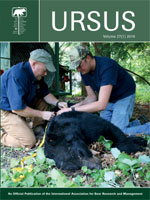Human–sloth bear (Melursus ursinus) conflict can be an important human safety issue where people and sloth bears co-exist. We characterized aspects of sloth bear attacks on humans using standardized surveys and interviews in Banaskantha, Sabarkantha, and Mehsana districts of North Gujarat, India. We interviewed 71 victims from 202 villages in the study area during 2008–2009; most attacks occurred during late monsoon (Oct) and early winter (Nov). Sloth bears typically attacked victims by charging, knocking them to the ground, and then rearing up on their hind legs. Most human injuries occurred on the arms (52%), legs (38%), and head (32%). Most victims were males (82%) traveling alone. We recommend education programs to reduce human injury through mitigation techniques. These efforts could include placing signs with information about sloth bear behavior and occurrence in the area and advising locals about when to enter forests, especially when alone, to reduce conflicts and facilitate coexistence of humans and sloth bears.
How to translate text using browser tools
1 May 2016
Assessment of human–sloth bear conflicts in North Gujarat, India
Karla C. Garcia,
Helly M. Joshi,
Nishith Dharaiya
ACCESS THE FULL ARTICLE

Ursus
Vol. 27 • No. 1
May 2016
Vol. 27 • No. 1
May 2016
attack pattern
human injuries
human–bear conflicts
India
Melursus ursinus
North Gujarat
safety issues




